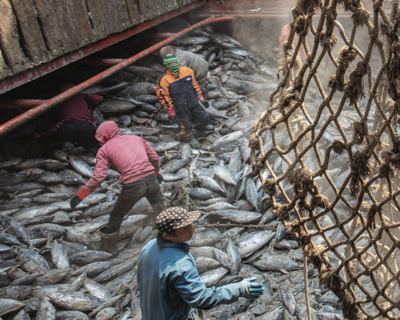Catch & release
Simulation to model capture & release to estimate populations
Questioning is the foundation of all learning.
The first step in rejecting not knowing is to ask, why?
Sweetland
Overview
Introduction
This page includes simulations to explore catch and release and recapture problems to learn how scientists and conservation officers determine fish populations in a pond or elsewhere to manage the envionment and fish populations.

Capture and Recapture Fish in a pond to estimate one species of fish's population
Is it possible to find how many fish there are in a pond without counting every fish?
Scientists use a method called catch and recapture to estimate animals' or a particular species' (kind or ainmal) population.
Purpose
To simulate counting animal populations.
Materials
Container or bowl; beans, cubes, or counters; pencil, erasable marker or stickers.
Procedure
Put an unknown number of the similar objects (hundred or more) in the container. The container, or bowl will represent a pond or other environment. The beans or cubes will represent the animals in the pond or the environement and population of a particular species of animals.
The pencil, marker, or stickers will be used to mark the animals that are captured,then released, and maybe, recaptured later.
Decide how many organisms to capture, tag and release (suggestions - 20, 25, 33).
Catch an animal, tag it, release it, and continue until the determined amount have been captured, tagged, and released.
Then begin to attempt to recapture, catch, the fish or animals one at a time, record if it is marked or unmarked, release it, and continue to catch more animals until 20 or more have been caught. (be sure to draw the beans, cubes, or counters without looking, record if it is marked or not, put it back into the container, and draw another until 20, 25, or more have been drawn).
With the information you have, you should be able to estimate the total number of animals in the population...
| Simulation | Number of animals tagged | Tagged animals caught | Untagged animals caught | Total animals caught | Total Population |
|---|---|---|---|---|---|
| 1 | |||||
| 2 | |||||
| 3 | |||||
| 4 | |||||
| 5 | |||||
| 6 |
Does it matter if you catch one animal at a time and release it, or if a whole group were collected at once (like caught in a net or grab a handfull of beans)?
Hint:
Animals tagged / total population = Tagged caught / untagged caught
Capture and Recapture Fish in a pond to estimate five species of fish's populations
Can capture, release, and Recapture be used to determine
the
number of fish in each species that are in a pond?
Is it possible to find how many fish of each species of all the fish species in a pond without counting every fish?
Scientists use a method called capture and recapture to estimate animals' or a particular species' (kind or ainmal) population.
Purpose
To simulate counting fish populations of all the species in a pond using ratio and proportion
Materials
Container or bowl; different kinds/ colors of beans, cubes, or counters; pencil, erasable marker or stickers.
Procedure
Put an unknown number of the different kinds objects (each kind represents a species of fish) for a combined total of a hundred or more in the container. The container, or bowl represents the pond. Different colors of cubes could represent the different species of fish populations in the pond. The pencil, marker, or stickers will be used to mark the fish that are captured, released, and maybe recaptured later.
Decide how many fish to capture, tag and release (20, 25, 33).
Catch a fish, tag it, release it, and continue until the determined amount are tagged.
Then begin to catch the fish one at a time, record if it is marked or unmarked, release it, and continue to catch more fish until 20 or more have been caught. (be sure to draw the beans, cubes, or counters without looking, record if it is marked or not, put it back into the container, and draw another until 20, 25, or more have been drawn).
With the information you have, you should be able to estimate the total number of animals in the population...
|
Tagged animals caught by species | ||||
|---|---|---|---|---|---|
Simulation number |
Species red |
Species brown |
Species black |
Species white |
Species yellow |
| 1 | |||||
| 2 | |||||
| 3 | |||||
| 4 | |||||
| 5 | |||||
| 6 | |||||
|
Untagged animals caught by species | ||||
|---|---|---|---|---|---|
Simulation number |
Species red |
Species brown |
Species black |
Species white |
Species yellow |
| 1 | |||||
| 2 | |||||
| 3 | |||||
| 4 | |||||
| 5 | |||||
| 6 | |||||
|
Total animals caught tagged and untagged by species | ||||
|---|---|---|---|---|---|
Simulation number |
Species red |
Species brown |
Species black |
Species white |
Species yellow |
| 1 | |||||
| 2 | |||||
| 3 | |||||
| 4 | |||||
| 5 | |||||
| 6 | |||||
|
Total Population by species | ||||
|---|---|---|---|---|---|
Simulation number |
Species red |
Species brown |
Species black |
Species white |
Species yellow |
| 1 | |||||
| 2 | |||||
| 3 | |||||
| 4 | |||||
| 5 | |||||
| 6 | |||||
Hint: solve a series of problems like captaure and recapture